Five sisters in Greece
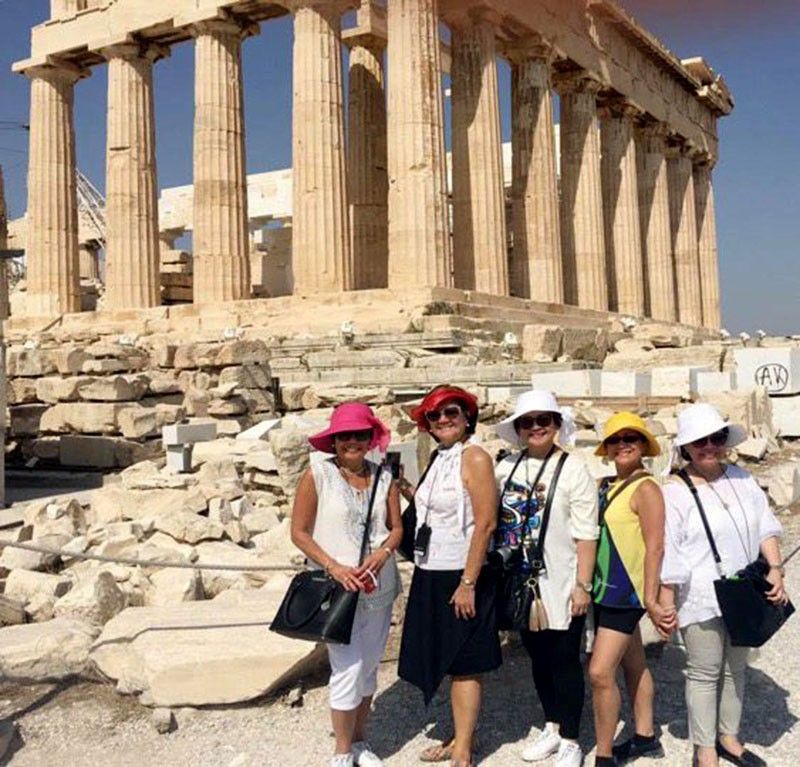
MANILA, Philippines — Greece was the unanimous choice for our five sisters’ traditional bonding trip. This country’s incredible natural beauty and mind –boggling artifacts of an unbelievable ancient civilization exceeded our expectations.
Sisters traveling together appears to be an oddity. People we have met during our travels have a distinct reaction whenever we reveal we are siblings. Many react with delight, some with surprise. A few have the look of incredulity — like it is beyond them to imagine traveling with their own kin.
Going on a previous seven-country motor coach tour throughout Europe for one of our sisters’ bonding trips prepared us for this weeklong land adventure dubbed “Classical Greece,” plus a three-night Aegean Sea Cruise.
On Day 1, we were free to venture on our own in Athens. We walked along Aleksandras Avenue to the National Archeological Museum where we got our first introduction to the marvels of ancient Greece and then walked around to get a feel for this city named for Athena. Our explorations around the city took us farther, so retracing our steps back to the hotel gave us a good appetite to sample local fare at an outdoor café such as chicken gyros, kebabs and lamb ribs.
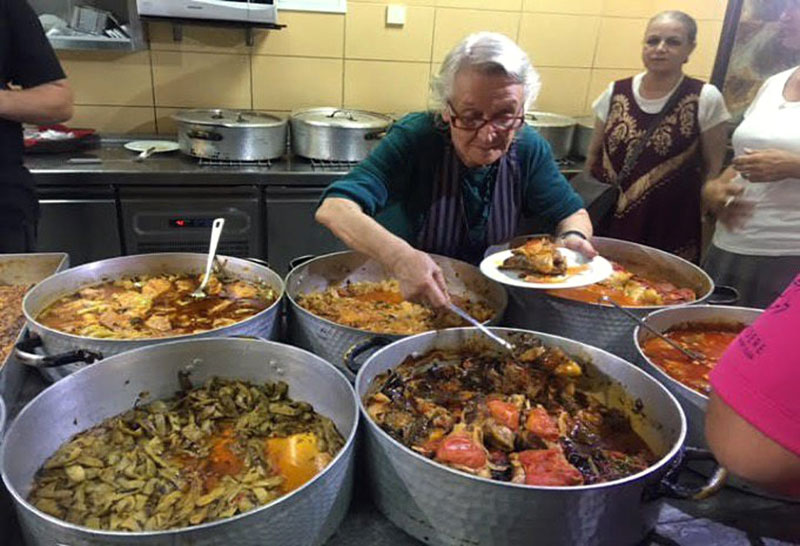
Mama Ketie, the octogenarian family cook who still reigns as the queen of her kitchen, personally dishes out her home cooked Greek meals which tourists find uniquely different from what is found in Greek Tavernas.
On Day 2, we piled into our tour bus for the first time and headed to the Acropolis (in Greek, “acro” means highest point and “polis” means city). We visited the most perfect building of all ages — the Parthenon Temple dedicated to Athena, the Goddess of Wisdom. There was scaffolding around the building where work was ongoing to preserve the integrity of the marble and the columns; but this did not mar its ethereal beauty. Gazing at the Parthenon, constructed around 447 BC, immediately brought back memories of lectures in UP humanities classes about the different orders of classical Greek architecture. It also intrigued us how the men of antiquity possessed the brains and brawn to build such structures, given the knowledge of engineering, equipment, tools and materials available then.
That evening, we were treated to a four-course Greek dinner and traditional folk dancing. Appetizers (moussaka, breaded kalamari, cabbage rolls, bread and tzatziki sauce, and cheese wrapped in phyllo) were served with ouzo, a liquor best consumed with one ice cube and a little water. The main course was stamnaki (beef cooked in a clay pot with cheese, tomato sauce and potatoes which reminded us of afritada with cheese). Dessert was loukoumades which are doughnuts drenched in honey. We participated in dancing the sirtaki, made famous in the movie Zorba the Greek.
A special canal in Corinth
Day 3 took us across the spectacular Corinth Canal, a collaboration between Greece and Austria to connect the Aegean and lonian seas, to Ancient Corinth, founded in 7000 BC. Corinth was the richest city in antiquity, which then made it the perfect target for St. Paul to introduce Christianity. It is there he wrote the letters to Thessalonians. He lived and preached for 1-1/2 years in the agora, the marketplace paved in white marble. An earthquake destroyed the ancient city so all that stands now are the ruins of the Temple of Apollo and the agora.
We then motored down to Mycenae, where 19th century excavations revealed ancient splendors such as the Beehive Tombs and the Lion’s Gate, Europe’s oldest known monument, the remains of Agamemnon’s Palace and then to Epidaurus, site of a 2,300–year-old open air theater which has excellent acoustics, as demonstrated by our tour guide who asked us to go up to the highest seats of the amphitheater to listen to the crisp sound of her tearing a piece of paper several rows below.
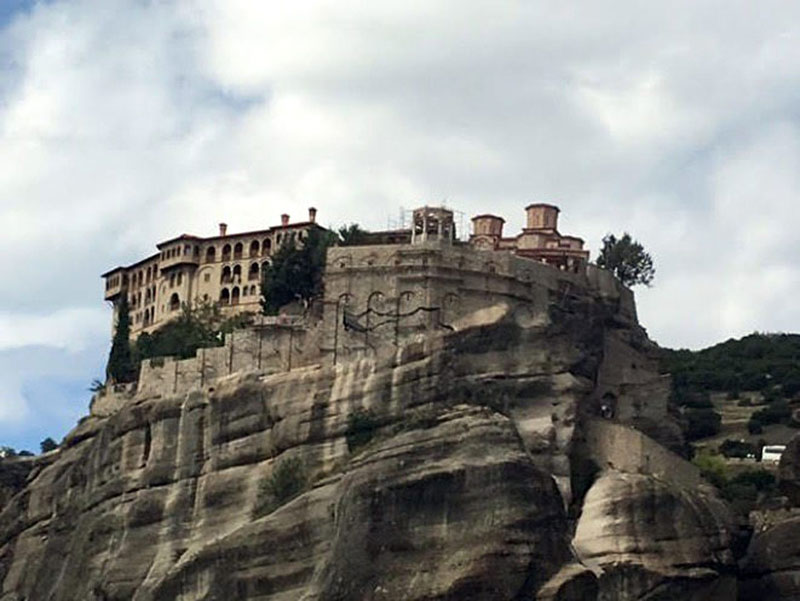
One of the 24 monasteries built atop of the mountains of Meteora, 5,000 feet above sea level
Day 4 took us through some spectacular scenery around the Arkadian Mountains. After lunch, we spent the afternoon in Olympia, the place where athletes of antiquity competed in honor of Zeus. At the center of Ancient Olympia was the temple dedicated to him, with a statue made of ivory and two tons of gold. It was sculpted by Phideas who also made the statue of Athena in the Parthenon.
The statue of Zeus was taken by Constantine and was never recovered. When Christianity took over Greece, a church was built in Olympia to purify the place from the worship of deities, which is why many of the artifacts were vandalized or stolen.
A visit to Delphi
On Day 5, we motored from Olympia to Delphi crossing the Rio-Antirrio Bridge, the world’s largest cable bridge, which connects western to southern Greece. We stopped for seafood at Itea, a coastal town by the Gulf of Corinth on the lonian Sea, where we had red snapper, calamari, shrimp and mussels. The fish and seafood were fresh and tasty.
Delphi is carved on the side of Mount Parnassus, one of Greece’s tallest peaks, and was dedicated to Apollo, son of Zeus and god of music and sun.
A temple for Apollo with a statue made of solid gold once stood there in the middle of other sanctuaries, a colosseum, and a stadium. Christianity and earthquakes destroyed Delphi, but the excavations still showcase a magnificent place of worship in such breathtaking natural surroundings.
The statues and artifacts in the Delphi museum include the largest 24-carat gold and ivory collection found on statues as well as the magnificent bronze statue of “The Charioteer” done around the 5th century BC. My sisters and I thought Delphi was the most spectacular of the places we visited.
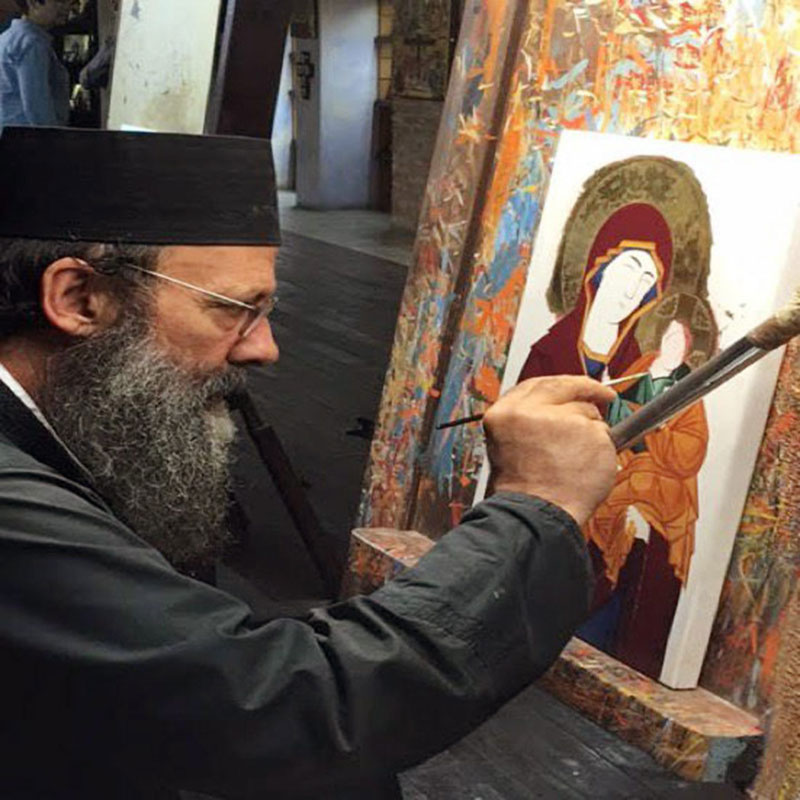
Fr. Pefki of the Greek Orthodox Church paints religious icons at a studio, together with his wife and son.
On Day 6, we left after a short hike downhill to see the ruins of the Temple of Athena just below the site of the Oracle of Delphi. Our four-hour drive to our next stop took us north to central Greece, going up the mountains to 5,000 feet above sea level. We stopped at the town of Kalambaka and had lunch at a taverna run by four generations of farmers. “Mama Ketie” still cooks everything from scratch using homegrown vegetables and meat from their livestock. Diners go through the kitchen to select and pick up their choice dishes. I had Greek meatballs over spaghetti (called “macaroni” which is the generic term for pasta) and was so pleased.
Our next stop was Meteora, a region in central Greece that has monolithic sandstone pillars upon which 24 monasteries were built between the 13th and 15th BC sheltering religious hermits who sought refuge from Turkish invaders and also to seek God’s glory and be closer to heaven. Only seven of the 24 monasteries remain. The monasteries on top of the pillars are a sight to behold and left us speechless. We toured Varlaam Monastery still occupied by 10 ascetic monks and St. Stephen’s Monastery, where 33 nuns live. The Byzantine frescoes in the monasteries as well as the religious artifacts are quite impressive.
‘Come and get it’
On Day 7, we visited the workshop of Fr. Pefkis, a master of Byzantine icons. We watched him and his son in action. We also stopped at the site of the historic Battle of Thermopylae where in 480 BC, Leonidas, the king of the city-state Sparta, led a small Greek band against the massive Persian army, delivered his famous line “Come and get it,” and became the epitome of bravery exhibited against overwhelming odds. His story has been featured in the film 300.
On Day 8, we headed for Lavrion where we boarded the Celestyal Olympia, our home for the next three nights.
Our first port of call that day was Mykonos, one of the smallest yet one of the most cosmopolitan islands in Greece. The town is completely whitewashed — houses are all cubical with colorful doors, windows and wooden balconies. There are 400 Greek Orthodox churches, all whitewashed with lime and their domes painted sky blue. We visited Little Venice with its picturesque coffeeshops, bars and restaurants and saw the famous windmills in the distance.
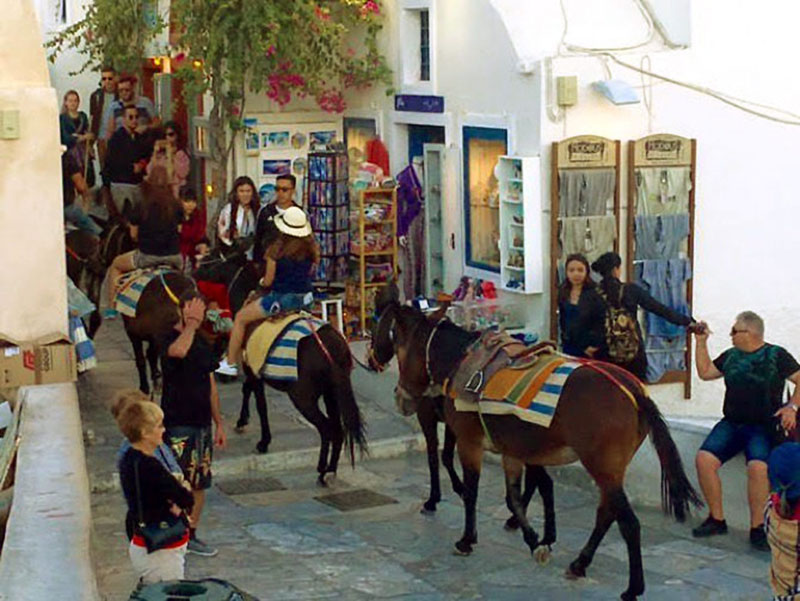
The donkeys in Santorini “announce” their arrival with the tinkle of bells.
On Day 9, we sailed to Kusadasi, Turkey where we took an optional tour of Ephesus. Our guide took us to the ruins of the ancient city where archeologists believe they have only dug up 15 percent of what earthquakes have buried over time. Ephesus has the largest outdoor museum in present-day Turkey and among the biggest in the world. It was the seat of the Temple of Artemis (twin of Apollo). It is a sacred site for Christians because Mama Mary, St. Paul and St. John the Evangelist lived there.
It was quite touching to enter the rock house where the Blessed Virgin ate, slept and prayed. It is believed she and St. John traveled to Ephesus after the Crucifixion and she stayed in that house until the Assumption. We also went inside the cave on Patmos where St. John saw the vision that inspired him to write “The Apocalypse.” There was something pretty surreal about being inside the cave and touching the hole in the wall upon which St. John’s hand had once rested to help him get off the ground.
Day 10 greeted us with tapsilog for breakfast, courtesy of our Filipino servers. Our port of call that morning was Crete, the mythical birthplace of Zeus, where we toured the ruins of Knossos Palace, built during the Bronze Age about 4,000 years ago. Later, we motored to Haraklion where we visited the Byzantine Church of St. Titus (where his sacred skull is displayed).
In the afternoon we sailed to Santorini. There were people everywhere but we were able to take in some extraordinarily beautiful sights around the main marble-lined avenue. After viewing the sunset, we rode the cable car down to sea level amid the breathtaking evening views to board the tender boats to the ship, thus marking the end of our cruise.
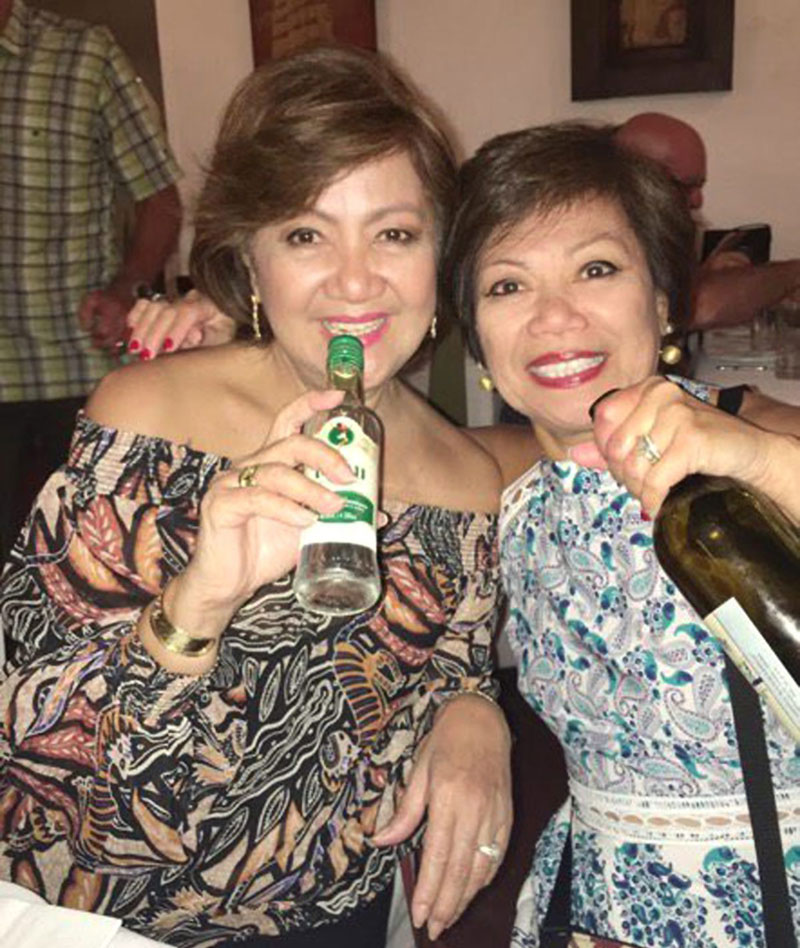
The first sip of Ouzo! Opa!: My sister Toni and I
On Day 11, we sailed back to Athens where we had a chance to witness the unique changing of the guards at the Parliament Building. After breakfast my younger sisters and I took a taxi to the cable car going up to the top of Lycabettus Hill where we could view the Parthenon from above and all of the city. We all met up at the hotel and had lunch at the rooftop restaurant, rested or packed the rest of the afternoon. After dinner, we said our goodbyes, as all prepared to go back to reality of home in the US and Manila.
I look back now and feel I am much wiser, having been to a city dedicated to the goddesses of wisdom and privileged to have seen some of the ancient world’s wonders. It is such a wonderfully giddy feeling, knowing my four sisters and I have shared another amazing experience and created memories we can take with us to our golden years. Efharisto, Lord, for this extraordinary opportunity! Till our next bonding trip. Opa!



















